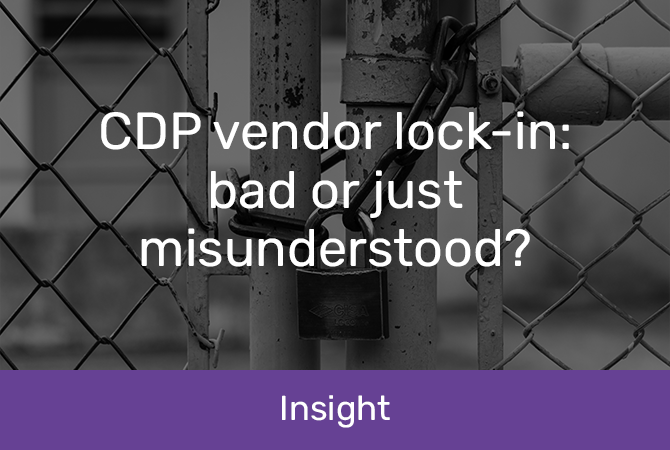CDP vendor lock-in: bad or just misunderstood?
When lock-in negatively impacts business agility and stifles innovation
Say you want to deliver highly relevant and engaging communications to customers as part of a wider insights-driven strategy. Sourcing the right data at the required frequency, then structuring it in a way that allows delivery of tightly defined use cases that unlock value, is key to success (and staying within budget).
There are two basic components to consider: firstly, the campaign management tool, and secondly, the underlying data layer and processes that feed that tool.
That’s where customer data platforms (CDPs) come in to structure and make sense of customer data, so you can create even more personalised and relevant marketing campaigns and content. Organisations of all sizes are understandably eager to capitalise on this, and software vendors have recognised the opportunity too.
Vendor lock-in isn’t a new challenge
CDPs are an increasingly common and central component of marketing automation software. That’s great news for organisations looking for a way to unify their customer data and simplify workflows, but it also comes with a risk of vendor lock-in.
In an ideal environment, users can switch between marketing automation platforms as their needs and requirements change over the long term. While vendors never explicitly prevent users from practising this freedom, they impose technical, financial and legal restrictions that make it hard for users to migrate massive amounts of data.
A state of ‘vendor lock-in’ is created and organisational control is diluted. You can end up with outdated technology that’s no longer fit for purpose, and unable to capture market opportunities as they arise.
The drawbacks of lock-in: managing customer data in a marketing automation platform
The downside of having customer data managed in a marketing automation platform is it can be very hard to switch out if the solution no longer suits your business, causing any number of roadblocks:
- Lack of flexibility. When a CDP is contained within a marketing automation platform, it can lack the flexibility needed to apply to other pockets of value. It is primarily set up to suit the needs of the platform, not the broader business requirements. Orchestrating campaigns and data initiatives across multiple touchpoints can become a challenge as data is generally not structured in a way that’s suitable for extraction, nor is the format useable by other parts of the business.
- Decline in vendor service quality. Or worse, it never meets the promised threshold. Once you’re on board, you’re stuck – even if the service doesn’t perform to your requirements.
- Change in product offer. Again, you’re at the vendor’s mercy and can’t do anything if it decides to dramatically change services.
- Pricing goes up. A vendor might add more capabilities to its offering to meet new demands – and increase the price of the service. While switching to another vendor might be more cost-effective, many organisations lack the time or resources to make the change.
- The platform goes out of service. A vendor may stop providing support, fixing bugs and adding new features to a platform if the product is no longer a priority for the vendor’s business strategy.
- A vendor goes out of business. Not overly likely for larger tech players, but certainly a risk for smaller providers.
Is vendor lock-in all doom and gloom?
There can be benefits to vendor lock-in. Going all-in with a single vendor can simplify workflows and increase productivity, potentially achieving better quality in one integrated interface that can be moulded to fill gaps in your existing tech stack.
However, the balance of power is typically in favour of the vendor. When you’re locked in, you’re reliant on your vendor to drive innovation, and in our modern “as a service” world, vendors can hit the kill switch at short notice, leaving you with little alternative and no time to migrate.
With marketing automation platforms, avoiding vendor lock-in by separating the data layer gives you the opportunity to delve deeper into the customer data using techniques such as machine learning and predictive analytics. This provides a richer analysis, while still being able to use these outputs within your marketing automation platform to execute campaigns and customer journeys.
Best practice for avoiding lock-in
Lots of organisations have the right ambitions when it comes to selecting a marketing automation platform with CDP capability, however, they have been let down by the promised benefits. If the underlying data isn’t built correctly, and the data flows don’t allow the full expression of the marketing automation platform capability, you’ll struggle to capture the opportunity.
The best practice is to build data layers that your organisation controls within your own environment, feeding a sophisticated, best-in-breed campaign management platform. That way, you can achieve flexibility in your tech infrastructure and operations while minimising the inherent risks that come from being overly dependent on one provider.
At Datamine, we can help you build that data layer so you can unlock the value of your marketing automation platform – without being locked in. Get in touch with us today.
















































